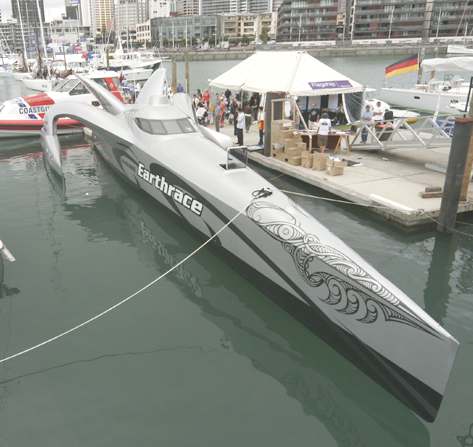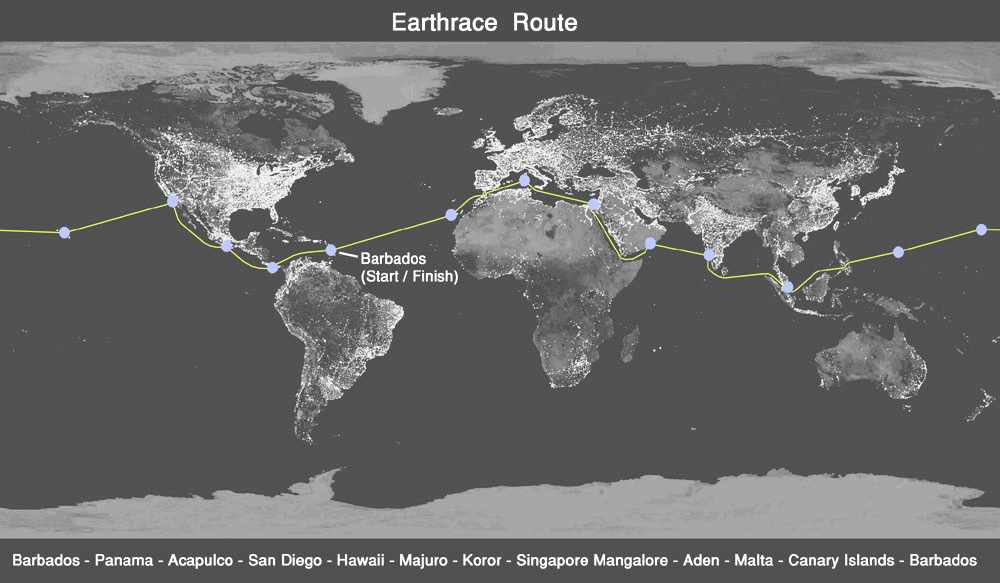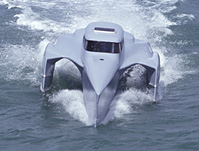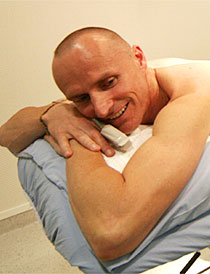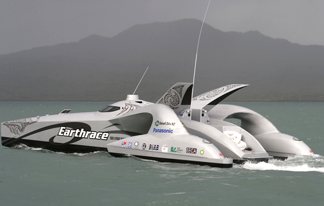|
EARTHRACE - Bio Diesel Boat
|
||
|
HOME | BIOLOGY | BOOKS | FILMS | GEOGRAPHY | HISTORY | INDEX | INVESTORS | MUSIC | NEWS | SOLAR BOATS | SPORT |
||
|
Earthrace
is a New Zealand-based bio-fuel powerboat project set to tackle a world
navigation and challenge the existing record held by the British boat Cable
& Wireless Adventurer. The boat is to be fuelled with 100% biodiesel, a fuel made from renewable sources such as canola and rape and will attempt to set the world record for circumnavigating the globe, to prove to the world that renewable fuels are synonymous with power and performance.
Earthrace - bio diesel powered world navigation contender
Prior
to Christmas 2005 project founder Pete Bethune announced that the team
had been forced to stop work on the project due to lack of funds. In
February work re-started due to a number of key donations. The
shortfall of approximately NZ $150 000 has been made up by sponsorship
from Biodiesel Oils NZ Ltd worth NZ$50 000 and Panasonic
totaling NZ$20 000, along with a contribution from Dubai of US$70 000.
The
actual cost of developing the boat proved to be more than anticipated
due largely to the complexities involved in developing and constructing
such an innovative design. The higher cost of Kevlar and Carbon, in part
attributable to the war in Iraq, also
contributed to budget overruns.
Bethune
says there is now nothing stopping the team from fulfilling their vision
of creating the greenest powerboat in the world. As well as using
sustainable fuels the Earthrace boat incorporates environmentally
friendly technologies such as low emission engines, non-toxic antifoul,
efficient hull design and solar powered electronics.
Powered by 100% renewable biodiesel fuel, The Earthrace is being built to attempt the global circumnavigation speed record. Its objective is to raise awareness of alternative fuels such as biodiesel, and to promote sustainable use of resources.
Bethune thanked all sponsors of the project to date and said he has been overwhelmed with the generosity and support received from the many companies and individuals who have demonstrated their commitment to promoting sustainable fuels and energy efficient design.
Following the launch the boat will commence an 18-month promotional tour, which will visit 60 major cities around the globe to highlight the benefits of renewable fuels. Included with the tour is a 500 person Panasonic Marquee Event Centre that will host schools and corporate events. The record bid will take place during the tour, when weather conditions are deemed most suitable.
Peter Bethune
More
about Earthrace
The Earthrace is an attempt to set the world record for circumnavigating of the globe. The boat is to be fuelled with 100% biodiesel, a fuel made from renewable sources such as canola and rape.
The current 75-day record is held by British boat Cable and Wireless in 1998, Earthrace aims to complete the race in less than 65 days. It is also the first time in history an official UIM Powerboat record will be attempted using renewable fuel.
The boat has a unique wave piercing hull that allows the boat to pierce through the water rather than riding over the top. Wave piercing technology was originally formulated for passenger ferry applications, and more recently it has been applied to military craft.
Wave
piercing is a key element in getting the record for circumnavigating the
globe as it allows the boat to run continuously at high speed in both
flat and rough sea conditions. The Earthrace has been funded to
date by sponsorship from more than 200 marine supplies companies who
have donated everything from onboard communications gear to high-tech
toilets. The boat will tour New Zealand from mid February through April.
ROUTE
Race rules state we must pass through the two canals, so the fastest route lies near the equator for much of the journey. There are two strategies for crossing the Pacific and Atlantic Oceans.
The northern route across the Pacific would take the boat up the coast of the US and Canada, crossing to Alaska then to Russia and down to Japan. For the Atlantic crossing, the northern route would travel around Gibraltar, across to the Azores, then over to Canada. These routes have an advantage in that the longest leg can be kept to only 900 nautical miles. This allows greater flexibility in boat design because there are no excessive restrictions on weight and fuel loads.
The southern route crosses both oceans directly, as shown on the map. This route places greater restrictions on boat design, principally because of the San Diego - Hawaii and Canary Islands - Barbados legs, which are 2400 and 2800nm respectively. This has the boat traveling over 5000km on a single tank of fuel.
Because the Earthrace boat has been designed to maximize fuel efficiency, the shorter Southern route has being made possible.
Race Route: Barbados - Panama - Acapulco - San Diego - Hawaii - Majuro - Koror - Singapore - Maldives - Aden - Port Said - Malaga - Canary Islands - Barbados.
WAVE PIERCING
Wave piercing technology was originally formulated for passenger ferry applications, and more recently it has been applied to military craft. Wave-piercers have a very fine bow with minimal reserve buoyancy in the forward portions of the hull to minimise vertical motions.
When a wave is encountered, the hull pierces through the water rather than riding over the top. The result is a dramatically smoother ride than traditional deep-V designs, minimizing stress on the vessel as well as the crew.
Wavepiercing is a key element in getting the record for circumnavigating the globe. It allows the boat to run continuously at high speed in both flat and rough sea conditions.
22' wave piercing prototype
SPECIFICATIONS
ENGINES
The Earthrace boat will run two Cummins Mercruiser QSC-540 engines. These engines were selected for several reasons. Firstly, they have very low emissions compared with other models the team has considered. Secondly, they are highly efficient, something paramount when you're looking to achieve the maximum possible range...and thirdly, they have one of the highest power to weight ratios of any similarly powered engine, and yet this is achieved while still maintaining high reliability.
There as also the fantastic worldwide support offered by CMD that made them the perfect partner for Earthrace. Whether we are in the Atlantic, the Pacific, Asia or Latin America, we know there will always be support close at hand, should we ever need it!
Peter Bethune - donating love handles
HUMAN FAT FOR FUEL - 10 November 2005
The Auckland adventurer has had about 100 millilitres – four syringes – of fat from his "love handles" removed by liposuction to literally fuel his record bid. And he is pleading for overweight people about to undergo the procedure to donate their fat to his cause. If Mr Bethune gets enough fat he will have it refined and converted to fuel for his futuristic 24-metre trimaran. Mr Bethune, 39, a former oil exploration engineer who has become a staunch biofuels advocate, said the idea of using human fat to power his boat was a publicity gimmick to promote his venture. He asked a couple of fat friends whether they would be willing to donate their spare kilos, but they told him he must do it first.
Remuera plastic surgeon Martin Rees – who did the procedure for free – had a real challenge finding much fat on Mr Bethune's lean 70 kilogram-frame. Surgery had left him feeling bruised – "it was like waking up the day after a hard rugby game." Mr Bethune said Mr Rees had to probe around a fair bit to get anything and the 100ml of fat extracted wasn't enough to yield fuel. By contrast, a typical liposuction operation may snare 3kg of fat. Once refined that amount could produce three litres of refined biofuel – enough to drive his Earthrace boat 2km.
Earthrace global mission
Mr Bethune has also put his wallet on the line for the world-record attempt. He's sold a business and a forestry block as well as mortgaged his house to help finance it. About 160 sponsors have already come on board. The $2.6 million Earthrace is expected to be launched on December 8 and will tour New Zealand before heading for San Diego in February. It will begin circumnavigating the globe in March. The aim is to cut the 75-day record. Earthrace has a top speed of about 50 knots and cruises at 25 knots. It is expected to use 70,000 litres of biofuels – mostly animal or plant fats – on the 50,000km trip.
Mr. Buthune is the founder of Earthrace, a campaign to highlight concerns about diminishing supplies of fossil fuels and the environmental advantages of biodiesel. Can human fat really power a diesel engine? “No one has actually made biodiesel from human fat before,” admits Mr. Bethune, “but we already do it with sheep and beef fat so it should work. Theoretically, at least.”
Animal fat is turned into fuel by removing the water and tissue, adding lye and alcohol, and then separating out the glycerine that results, leaving biodiesel. “The amount of energy from fat is relatively low,” says Mr. Bethune. “A large liposuction operation involves removing 10 pounds of fat, which would drive a car about 50 miles once converted.”
Earthrace breaks the world circumnavigation record
Mr. Buthune says that his visit to the plastic surgeon was “sort of a joke,” but was meant to publicize the potential of biofuels, which can be manufactured from fast food cooking oil, various seed crops, and animal fat from meat and fish processors. Such sources are renewable, and much of it goes to waste now.
Mr. Buthune nevertheless thinks the use of human fat as an energy source has some potential. “There’s an interesting business model: link a biodiesel plant with the cosmetic surgeons,” says Mr. Bethune. “In Auckland we produce about 330 pounds of fat per week from liposuction, which would make about 40 gallons of fuel. If it is going to be chucked out, why not?”
Mr. Bethune is not encouraging people to help save the environment by having liposuction. He says, “Liposuction is not a small procedure.” Yesterday’s operation left him as bruised as he is after a hard rugby game. He observes that “the thought of a tube stuck in your arse and feeding into the fuel tank does sound like the nirvana of transport fuels. Just feast at McDonald’s twice per day.” But he goes on to say, “If you went in for liposuction every year just to stay slim you’d be causing more damage than remaining a fat bastard, because the procedure is invasive.”
Mr. Bethune would prefer that there not be so much human fat in the first place. His proposed solution? “Really, obesity needs to be solved by public transport, which forces people to walk, exercise, and eat a better diet.” Readers who wish to follow the progress of the Earthrace project can visit the Earthrace web site, which contains photos, video, technical details about the boat design, and information about biodiesel fuels.
Earthrace wave piercing boat
CONTACTS
LINKS
http://www.earthrace.net/view.asp
http://calorielab.com/news/2005/11/11/biofuel-promoter-to-power-boat-using-human-fat/
A taste for adventure capitalists
Solar Cola - a healthier alternative
|
||
|
This
website
is Copyright © 1999 & 2012 NJK. The bird |
||
|
AUTOMOTIVE | BLUEBIRD | ELECTRIC CARS | ELECTRIC CYCLES | SOLAR CARS |
